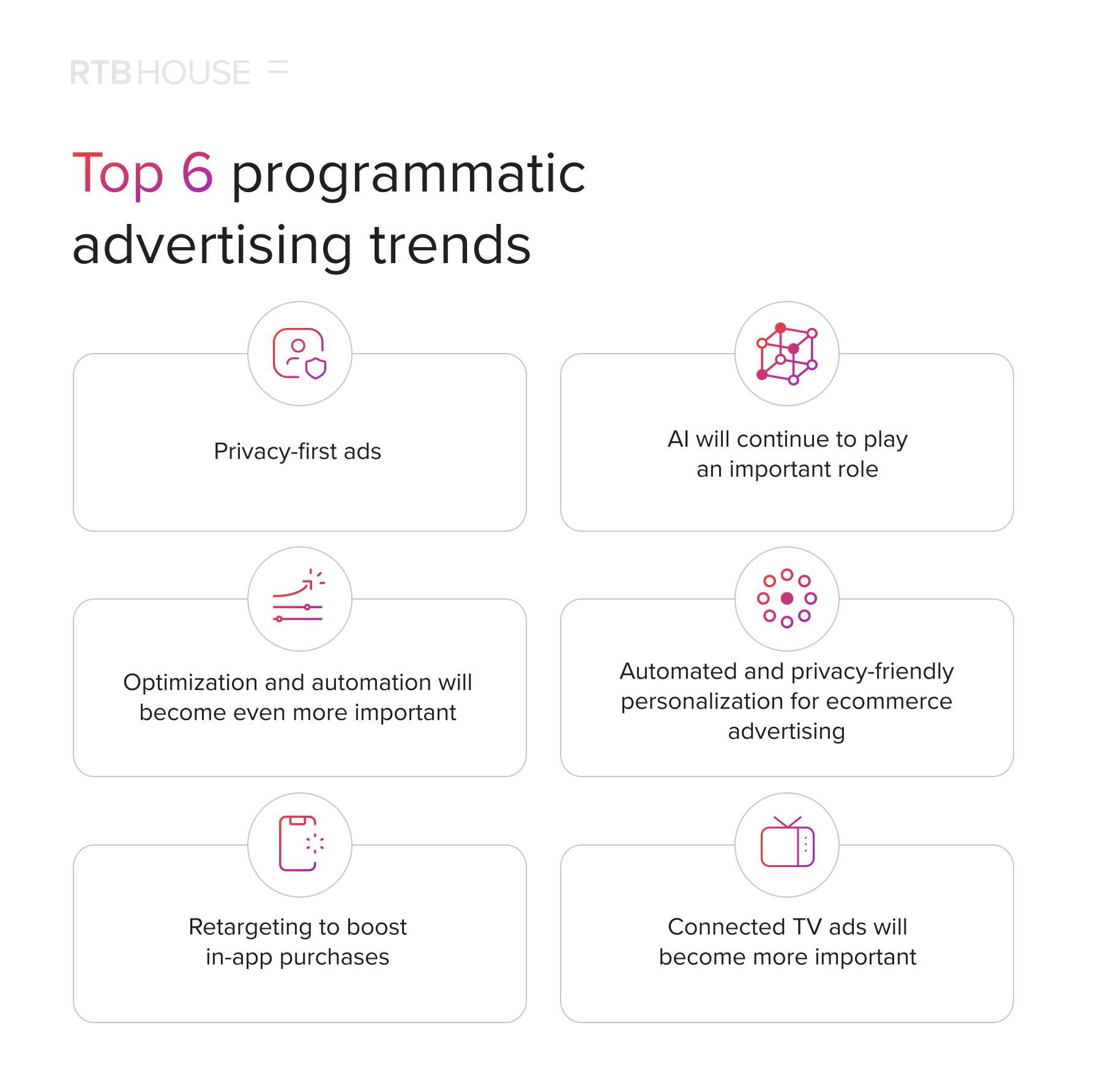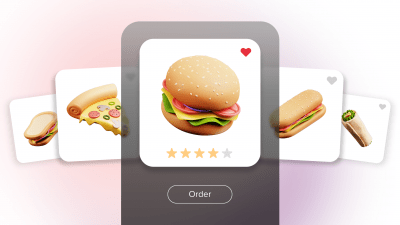Last Updated on: 10th October 2024, 08:23 am
The programmatic advertising ecosystem is evolving rapidly thanks to advances in targeting, personalization, and Deep Learning data analysis. This means advertisers have an ever-expanding toolbox that they can use to connect with customers. To help you make the most of these advances, we’ve analyzed our internal data to identify the top programmatic advertising trends right now.
In this article, you will learn:
- The definition of programmatic advertising.
- A brief history of how programmatic advertising has evolved over the past few years.
- The top programmatic advertising trends, and how you can use them to your advantage.
Table of Contents:
- What is programmatic advertising?
- Programmatic advertising trends you should know
- Trend 1 – Privacy-First Ads
- Trend 2 – Artificial intelligence will continue to play an important role
- Trend 3 – Automation will become even more important
- Trend 4 – Automated and privacy-friendly personalization for ecommerce advertising
- Trend 5 – In-app advertising
- Trend 6 – Connected TV ads will become more important
- Learn how you can take advantage of the latest programmatic advertising trends today
What is programmatic advertising?
Programmatic advertising refers to systems that automate the buying and selling of online ad space, using technologies that enable real-time bidding (RTB) across a variety of platforms. Programmatic advertising is operated by two separate groups of platforms:
- Demand-side platforms (DSPs) — place bids on ad impressions and represent the advertiser or marketer.
- Supply-side platforms (SSPs) — enable publishers to sell ad space that DSPs can bid for.
The whole process is facilitated by ad exchanges, which aim to pair the highest bidders with the best available impression in an instant. Programmatic advertising is the lifeblood of the modern advertising industry — it enables publishers to show ad-supported content free of charge while helping businesses connect with customers who are actually interested in their products.
While programmatic advertising has made it easier than ever to advertise, it has also led to a boom in competition for ad space. Digital ad spend in 2023 was $718.6 billion globally, and this number is only expected to grow. This means that marketers and businesses need to adopt increasingly sophisticated tools to keep up with programmatic advertising trends and secure the best ad spots.
Programmatic advertising trends you should know
A lot has changed in the programmatic advertising space over the past few years. Technology has improved, consumer attitudes towards ads have changed, and the way we all shop has continued to evolve. Let’s dive into the 6 most important programmatic advertising trends, and how you can apply them to your business.
Trend 1 – Privacy-first ads
A big trend to watch is the rising importance of privacy-first advertising. While Google has walked back its plans to fully depreciate third-party cookies, giving users a choice whether they want 3rd party cookies in their Chrome Browser or not, the conversation about privacy and ads persists. Even though Google will continue to allow tracking cookies, the decision to make it easier for Chrome users to opt out will mean that many users may suddenly be out of reach for advertisers using traditional, cookie-reliant tracking methods.
Something similar happened when Apple rolled out App Tracking Transparency (ATT), which caused significant addressability challenges for marketers across the entire iOS ecosystem. However, there is one big difference — while Apple didn’t provide advertisers with any alternative methods to reach customers, Google has made great efforts to provide ways to reach customers who opt out of third-party cookies via the Privacy Sandbox.
If a large number of users opt out, advertisers will lose access to a large portion of customers. Third-party cookies currently track users across the internet and give marketers insights into how a user thinks and what they want. Once they are depreciated, marketers will lose access to that data and therefore lose the ability to reach users with personalized ads without using Google’s Privacy Sandbox.
Despite this risk, the majority of marketers still rely on third-party cookies and are unprepared for the Privacy Sandbox, which means they risk being outcompeted by early adopters.
Trend 2 – Artificial intelligence will continue to play an important role
Large Language Models have already taken the world by storm, and use of Generative AI’s image generation capabilities is disrupting the graphic design space. However, advanced artificial intelligence isn’t just impacting the creative side of programmatic advertising.
For years now, advanced algorithms have been used to make decisions about what ads to show, and where to purchase ad space. This is set to become even more important as fewer users opt into cookies, and advertisers lose access to their data. They will need to rely on more complicated Privacy Sandbox APIs in order to make intelligent decisions about what ads to show, and when to show them.
One solution to this problem is something we know a lot about — Deep Learning. These advanced algorithms are able to rapidly interpret complicated unstructured data and generate useful insights that can be applied in a variety of ways. This is becoming increasingly important amid signal loss from the partial introduction of the Privacy Sandbox.
For example, Deep Learning can enhance audience targeting by identifying complex patterns of information that accurately predict what type of product and advert is most likely to connect with a specific user, or group of users. Deep Learning can predict which users are most likely to engage with an ad based on their past behavior, improving the overall effectiveness of ad placements over time.
This same concept can also be used to improve the effectiveness of real-time bidding (RTB). Deep Learning algorithms can analyze bid requests in real-time, and dynamically adjust bids to optimize for the highest return on investment (ROI), ensuring that advertisers win the most valuable impressions at the best possible price.
Finally, it can be used to enhance ad personalization. By understanding a user, the algorithm can predict what message and creative is most likely to resonate. This improves the overall effectiveness of the ad and increases the likelihood of conversion.
All of this means that Deep Learning can provide a significant boost to any programmatic advertising campaign.
Trend 3 – Optimization and automation will become even more important
Automation has been one of the big longstanding programmatic advertising trends, and that isn’t set to change anytime soon. With the entire bid process happening in a fraction of a second, marketers’ systems need to be finely tuned in order to remain competitive.
This is achieved by using a variety of automated tools that automatically identify and bid on the best opportunities. These tools are used by DSPs and are typically some form of artificial intelligence. The entire process takes place in a fraction of a second, and any kind of delay can significantly compromise the effectiveness of your programmatic advertising campaign.
Because of how fast bids are placed, every company now has to use automated tools to compete for ad space. This means that winning a bid often becomes a race to see who has the best automation approach. This has led to a lot of innovation — for example, at RTB House we use Deep Learning algorithms to determine how high to bid, and what products to show in an ad.
Trend 4 – Automated and privacy-friendly personalization for ecommerce advertising
Personalization is hugely important for many users, with our promo periods report showing that customers are 76% more likely to purchase from a brand that personalizes their ads. This is why practically every marketer dynamically adjusts banner templates, and why further optimization and improvement of this ability is an ongoing programmatic advertising trend.
While users do want personalization, brands also need to keep privacy in mind. By leveraging advanced algorithms and novel cookieless retargeting solutions, brands can continue to reach users, while ensuring their ads respect user privacy. This improves customer trust and the overall effectiveness of ads.
The more effective a given banner is, the more likely it is that it will be shown to other users. This optimizes the campaign’s creative in real-time and helps to ensure the highest return on ad spend (ROAS) for the business running the campaign.
This is particularly helpful in the context of ecommerce, where you can go a step further and not just optimize what creative a user sees but also what product categories they are shown. Subtle insights can be used to determine products that a user might be interested in, even if they haven’t yet interacted with that specific product or product category. This can all be achieved without any human intervention.
Trend 5 – Retargeting to boost in-app purchases
With 67% of adults playing at least one video game, and gamers spending an average of 12.8 hours a week on their hobby, there are a lot of opportunities available for monetization, particularly through in-app purchases.
To drive these purchases, games need to keep users engaged as long as possible. Retargeting is a powerful tool to remind users why they love a game and why they may want to maximize their fun through in-app purchases.
The best way to effectively engage your users is to infer insights based on user data. These insights are then used to properly evaluate and place bids. For example, you might want to connect with a user while they are using another app or game by displaying an ad that encourages them to return to your game. In this way, as they spend more and more time engaged with your game, you can increase the probability that they make a purchase.
Trend 6 – Connected TV ads will become more important
One of the big advantages of digital advertising over traditional TV advertising has been the ability to tailor ads to a specific audience. Connected TV (CTV) ads offer this ability by delivering ads to users through internet-connected devices. These ads are served through streaming platforms and exist in a variety of formats such as pre-roll, mid-roll, or post-roll ads.
CTV ads are significantly more targeted than traditional TV ads. They can take advantage of the same data used by regular digital advertising campaigns to provide users with deeply personalized, and even interactive, ads.
Another major advantage of CTV ads is measurable performance. Unlike with traditional TV ads, marketers who use CTV ads are shown a range of statistics that inform them how successful their ad campaign has been. This allows them to make adjustments as needed to increase the ads’ effectiveness.

Learn how you can take advantage of the latest programmatic advertising trends today
Our team at RTB House has a wealth of experience in programmatic advertising and is standing by to help your company take advantage of our knowledge. Whether you simply want to improve your ROAS in a digital campaign or learn how to boost your preparation efforts for the changes to cookie availability in Chrome with Deep Learning, we are here to help.
To get started, contact our team today.





